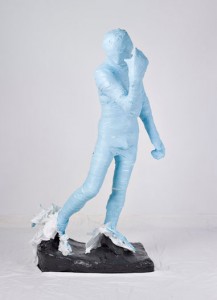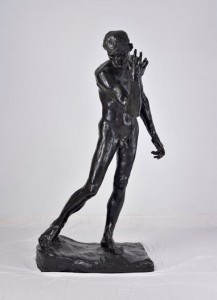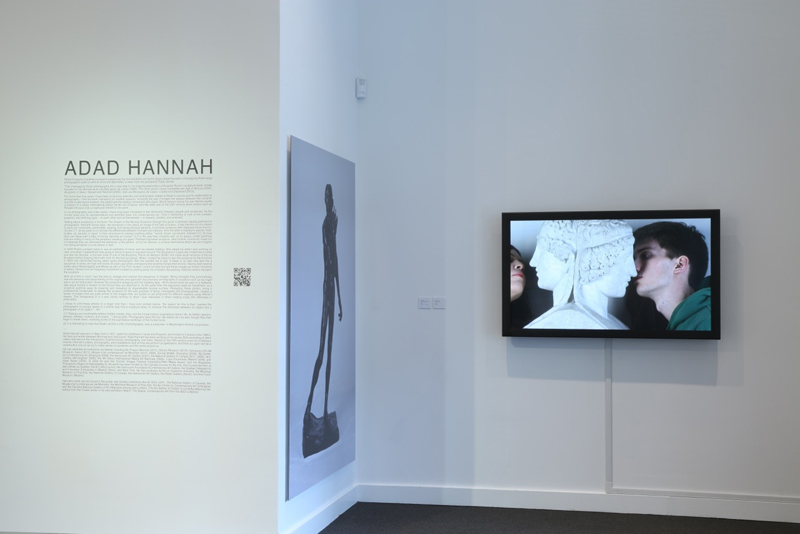 The Unwrapping Rodin photographs are a new step in my ongoing exploration of Auguste Rodin’s sculptural work, mostly focused on his seminal work Les Bourgeois de Calais (1895). The other works I have completed are Age of Bronze (2004), Burghers of Seoul: Recast and Reshoot (2006), and Les Bourgeois de Calais: Crated and Displaced (2010).
The Unwrapping Rodin photographs are a new step in my ongoing exploration of Auguste Rodin’s sculptural work, mostly focused on his seminal work Les Bourgeois de Calais (1895). The other works I have completed are Age of Bronze (2004), Burghers of Seoul: Recast and Reshoot (2006), and Les Bourgeois de Calais: Crated and Displaced (2010).
For more than five years I have been producing artworks and writing texts related to Rodin’s oeuvre and its relationship to photography. I find his work interesting for several reasons, including the way it bridges the spaces between the romantic and the modern/post-modern, the object and the replica, movement and stasis. World famous during his own lifetime (partly a product of a newly international press) he fell out of favour until the latter part of the 20th century when writers such as Rosalind Krauss took a newfound interest in his work.
In my photography and video works I have long been interested in the dichotomy between people and sculptures. As the human body and its representations are admitted back into contemporary art, I find it interesting to look at the creative, powerful, and defining gaze – at each other and at themselves – of viewers, models, and artworks.
Talking about sculptures in his book The Dream of the Moving Sculpture (though this quote is perhaps equally pertinent to photographs) Kenneth Gross says, “we recognize in the statue an image of the fate of bodies, a fate elected out of a desire to deny our vulnerable, penetrable, wasting, and dying physical persons, to provide ourselves with idealized stone mirrors” (Gross 17). Gross goes on to itemize the differences between humans and statues, from the latter’s inability to absorb “food, bullets, air, sounds, or signs” to their reluctance to release anything either (“words, blood, excrement, children”)[1]. So how then can these inert lumps of bronze become so human? Is it in the way they compete with us for space, unlike paintings that are willing to hang on the periphery awaiting our gaze? Perhaps figurative sculpture, often hollow, commonly made out of materials that can withstand the elements, is the perfect foil for our desires; a surface shell below which we can imagine into being whatever it is we desire or fear.
In 2005 Phyllis Lambert came to see an exhibition of mine, and we started chatting. She asked me what I was working on next, and when I replied that I was going to Seoul to work on a project around The Burghers of Calais she invited me to come and see her Burgher, a full-size nude of one of the Burghers, Pierre de Wissant (Rodin first made nude versions of the six Burghers before draping them with cloth for the final grouping). When I visited her place to see this sculpture for the first time in 2005 she mentioned having taken some photographs that she wanted me to see. A week or so later she sent me a sequence of slides she had shot some 30 years ago while unwrapping the recently transported bronze. Having read several books about Muybridge[2] and Marey as part of my PhD studies I could not help but see these images as frozen moments of action, frames from an imaginary movement created by peeling away the chrysalis-like packing material used to transport the sculpture.
With all of this in mind I had the idea to restage and reshoot this sequence of images. Being restaged they automatically lose the personal and loose feeling of the originals and approach documentary photographs of sculpture such as we might see in an art history text. However the protective wrapping and the masking tape, which would never be seen in a textbook, take equal footing in relation to the bronze they are attached to. At the same time the sequence reads as movement, as a sculpture pushing away its covering and revealing its impenetrable bronze surface. Restaging these photos, hiring a professional conservator to rewrap the sculpture for the sole purpose of being unwrapped and photographed, creates a series of images that are quite similar to the images they are based on yet produced for different reasons using different means. This transposing is in a way similar territory to what I was interested in when making Cuba Still (Remake) in 2004-2005.
I chose to print these photos at a larger size than I have ever printed before, the reason for this is that I wanted the photographs to occupy space in a similar way that a sculpture does, to confuse the distinction between an object and a photograph of an object.
-Adad Hannah
[1] “Statues are comfortably without hidden insides; they void the human body’s scandalous interior life, its hidden spasms, desires, reflexes, motions, and noises…” (Gross p32). Photography does this too. My videos do it as well, though they then begin to break down, revealing some of the scandalous workings of the human body. [2] It is interesting to note that Rodin, at first a critic of photography, was a subscriber to Muybridge’s Animal Locomotion.Adad Hannah was born in New York in 1971, spent his childhood in Israel and England, and moved to Canada in the 1980’s. He lives and works between Montreal and Vancouver. Adad Hannah has been working on his series Stills consisting of silent videos that exist at the intersection of performance, photography, and video. Based on the 19th-century practice of tableaux vivants, Hannah’s videos, photographs, and installations look at how we perform as spectators, and how our gaze can be a constructive one as we try to make sense of ourselves and the world around us.
He has exhibited at institutions worldwide including the Prague Biennial (2011), Aldrich Museum (2010), Samsung LEEUM Museum, Seoul (2011), Musée d’art contemporain de Montréal (2010, 2008), Zendai MoMA, Shanghai (2009), Ke Center for Contemporary Art (Shanghai 2008), the Vancouver Art Gallery (2007), the National Gallery of Canada (2011, 2006), Ikon Gallery (Birmingham 2006), the 4th Seoul International Media Art Biennale (2006), Casa Encendida (Madrid 2006) and Viper Basel (2004). In 2004 he won the Toronto Images Festival Installation/New Media Award, and the Bogdanka Poznanovic Award at Videomedeja 8. His work has been funded by the Canada Council for the Arts, the Conseil des Arts et des Lettres du Québec, the B.C Arts Council, the Vancouver Foundation/Contemporary Art Gallery, the Quebec Delegations and Canadian Embassies in Madrid, Seoul, and New York. He has produced works at museums including the Montreal Museum of Fine Arts, the National Gallery of Canada, the Vancouver Art Gallery, the Rodin Gallery (Seoul), and the Prado Museum (Madrid).
Hannah’s work can be found in the public and private collections like Sir Elton John, the National Gallery of Canada, the Musée d’art contemporain de Montréal, the Montreal Museum of Fine Arts, the Ke Center for Contemporary Art (Shanghai) and the Zacheta National Gallery of Art (Warsaw) among many others.
—
PHOTOGRAPHS


Unwrapping Rodin (Blue) 1 Unwrapping Rodin (Blue) 2
2010 2010
c-print c-print
175.25 x 127 cm (69″ x 50″) 175.25 x 127 cm (69″ x 50″)
edition of 2 edition of 2


Unwrapping Rodin (Blue) 3 Unwrapping Rodin (Blue) 4
2010 2010
c-print c-print
175.25 x 127 cm (69″ x 50″) 175.25 x 127 cm (69″ x 50″)
edition of 2 edition of 2


Unwrapping Rodin (Blue) 5 Unwrapping Rodin (Blue) 6
2010 2010
c-print c-print
175.25 x 127 cm (69″ x 50″) 175.25 x 127 cm (69″ x 50″)
edition of 2 edition of 2


Unwrapping Rodin (Blue) 7 Unwrapping Rodin (Blue) 8
2010 2010
c-print c-print
175.25 x 127 cm (69″ x 50″) 175.25 x 127 cm (69″ x 50″)
edition of 2 edition of 2

Unwrapping Rodin (Blue) 1
2010
c-print
175.25 x 127 cm (69″ x 50″)
edition of 2
—
INSTALLATION




